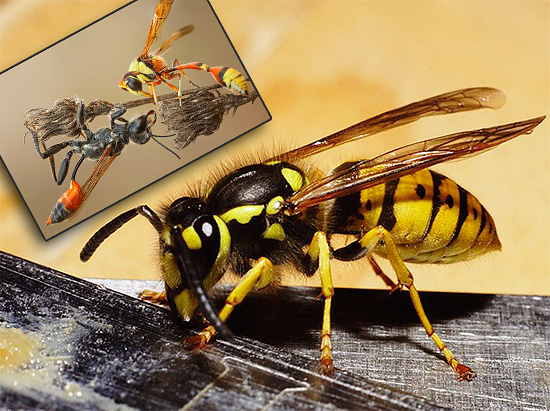
The wasps are in many respects unique to the insect, starting with the manner of their nutrition and reproduction, and ending with the composition of the poison and self-defense abilities. All wasps belong to the order of Hymenoptera, which, in addition to them, also includes numerous bees, ants, bumblebees, riders and sawflies.
Long-term studies of representatives of this order led most evolutionary scientists to conclude that one part of insects (for example, equestrians and sawflies) are independent groups that develop in parallel, and the other (bees and ants) are already descendants of ancient wasps. At a certain stage of evolution, they developed the ability to feed and feed their offspring only with the nectar of flowers (which is typical of bees), or their wings were lost, and their way of life became terrestrial or woody (this is the main feature of ants).
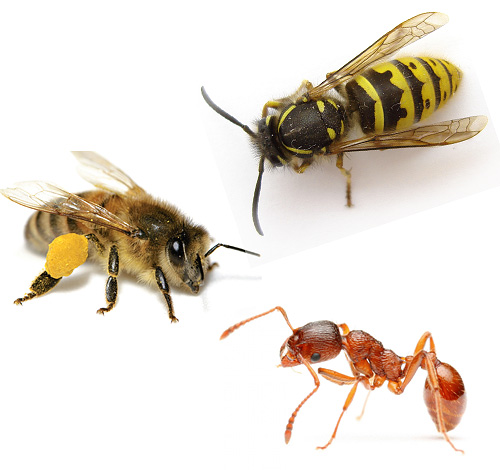
It is interesting
Many primitive species of ants very similar to predatory burrowing wasps. For example, the Australian ants, the Bulldogs, are very similar to the wingless wasps and even have a sting and a very strong poison.
The first photo shows a German wasp, and below is the ant bulldog:
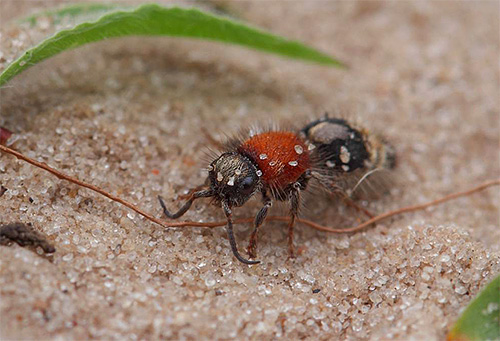
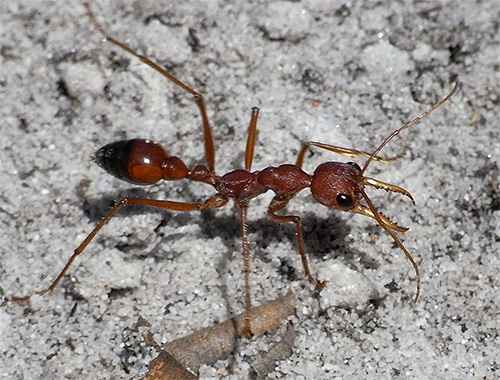
Wasps are insects, among which almost equally living as well as collective species are represented. Therefore, for biologists, they are very convenient objects for studying the transition of animals from a single independent existence, first to simple colonial life, and then to social interaction with the caste structure of the family.

Scientists have not yet reached a consensus regarding the stable and unambiguous classification of wasps. Today, they are divided into several families and groups, representatives of which, depending on new research conducted, sometimes move from one group to another.
The first level of this classification divides the family of wasps into singly living insects and social ones. The following families of wasps belong to singularly living:
- digging
- sandy;
- flower;
- road;
- German wasps;
- shiny wasps;
- scolii;
- Typhia.
The group of social insects includes the family The real wasps (however, this includes some species of sand wasps).
A great example of insects living in families is, first of all, paper wasps - it is the summer residents of our country that most often encounter with them.
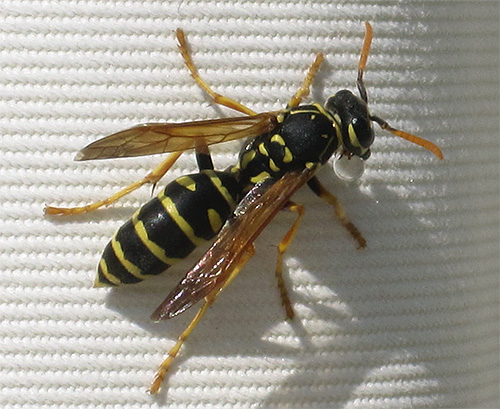
In addition, hornets, also belonging to the family of these wasps, are quite well-known public insects.
On a note
The main difference between the hornet and the usual wasp is its large size. If paper wasps have a length of only 2-3 cm, then this indicator reaches 3-3.5 cm for European hornets. In addition, hornets have a wider nape (this is clearly seen under a magnifying glass) and characteristic dark red spots on the head there where paper wasps have black spots. The hornet differs from a wasp in a more peaceful disposition - it bites a person much less frequently.
In the following photo, the hornet and the wasp are located nearby, which makes it possible to estimate the difference in their sizes:
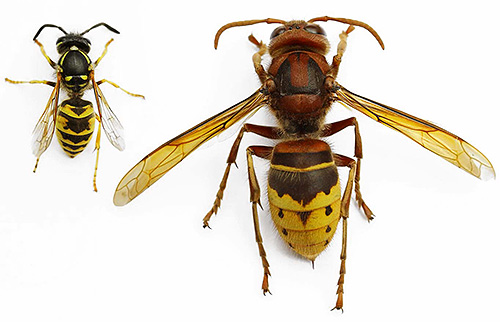
The pictures below show different types of wasps (digging, wasp and glossy wasp, respectively):
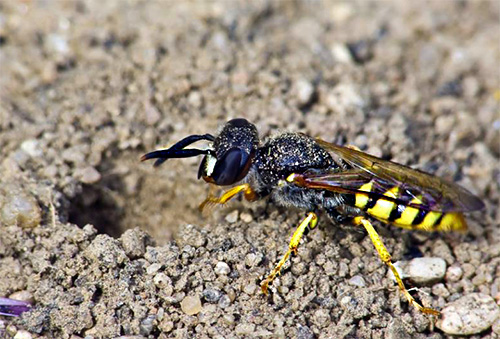
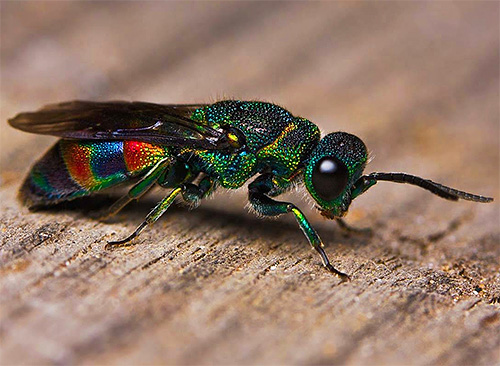
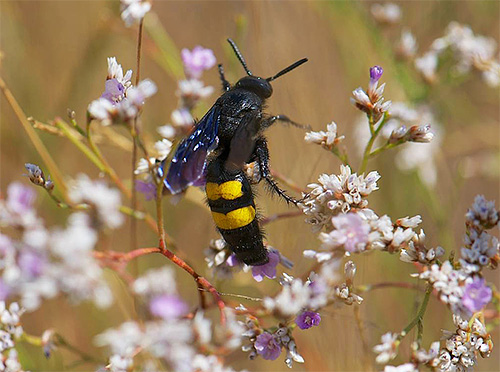
Interesting wasp anatomy
The wasps belong to the suborder of the stalked-winged hymenoptera.Only one glance at the structure of the wasp makes it possible to understand why the suborder received such an unusual name: between the chest and abdomen of this insect there is a narrow “waist” that resembles a long, thin stalk in some wasps.
Due to this peculiarity, wasps can easily fold their body almost twice and sting their prey from almost any angle - this allows them to win fights with other insects, sometimes even larger ones.
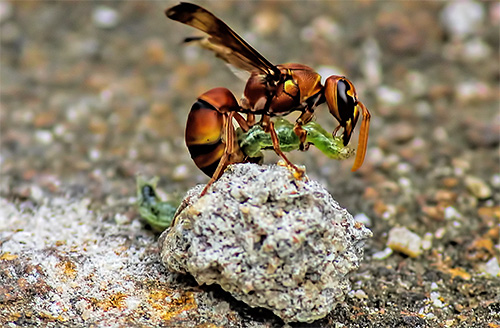
The body of the wasp is subdivided into three well distinguishable segments — the head, the chest, and the abdomen, and has a strong outer chitinous skeleton. The head of the wasp is very mobile and crowned with two antennae that perform many functions: they capture odors and vibrations of the air, with the help of them the insect can evaluate the taste of liquid food and measure the length of the honeycomb in the nest.
The photo shows the head of a wasp at high magnification:
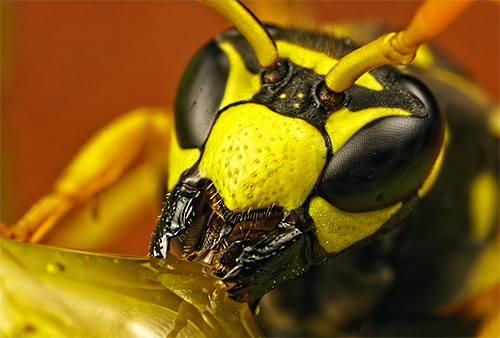
Each wasp is endowed with nature with powerful jaws - mandibles. They serve both for the nutrition of vegetable food - soft fruits, berries, flowers - and for the killing of prey. For example, the majority of hornets, attacking even such large insects as cockroaches and praying mantises, practically do not use the sting, but are completely costly only with strong jaws, which successfully crush chitinous integuments of their victims.
In the photo, the wasp caught a fly:
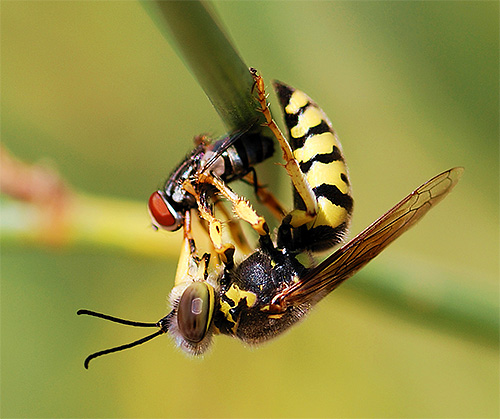
The speed of the flight of a wasp is quite high, but, however, it is not a record one for insects as a whole. That is why even well-armed striped predators often become victims themselves - for example, large predatory flies and dragonflies.
As for the coloring, then here the wasps stand out from all other insects with a worthy variety. For example, some types of paper and flower wasps have bright contrasting black and yellow stripes and look like they cannot be recognized.
Other species may have a completely different color: from rich black to turquoise and violet. In any case, the color of the body of these insects is always well recognized (especially in the animal world) and allows them not to fall prey to an accidental attack, frightening off many mammals and birds.
In the first photo you can clearly see what the German wasp looks like - the usual look in Europe:

And this photo shows a sparkle of fire, painted in unusual (due to the lack of black and yellow coloring) colors:
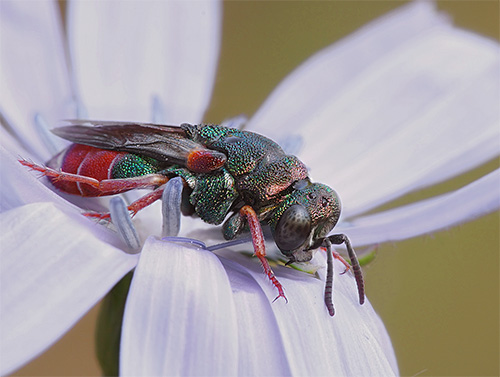
It is interesting
It was the wasps that have the largest number of insect imitators that copy their color and appearance to protect against predators.A great example is the hoverfly fly, which looks very much like a wasp. Birds and mammals, knowing that the body of an insect in a black and yellow strip usually has a dangerous sting, bypass it. The very same fly wasp is absolutely harmless.
A photo of a hoverfly fly - black and striped coloring really gives it a formidable look:

It is noteworthy that the body of most of the wasps does not have such a huge amount of hairs on the body, such as, for example, in bees and bumblebees. This is due to the fact that the last two groups of insects are typical pollinators, and hairs help them to increase the efficiency of nectar collection on flowers. In the wasps - in the overwhelming majority - there is no need for such a covering of the body, only some parasitic species have dense pubescence, saving them from the attacks of the owners of the infected nests.
It is interesting
Some species of wasps do not have wings at all. Such are, for example, German wasps parasitizing in the nests of their paper “brothers”. The absence of wings does not prevent them from having a sting and a very strong poison.
The wasp has five eyes: two large faceted, located on the sides of the head and providing a wide angle of view, and three small eyes on the forehead.
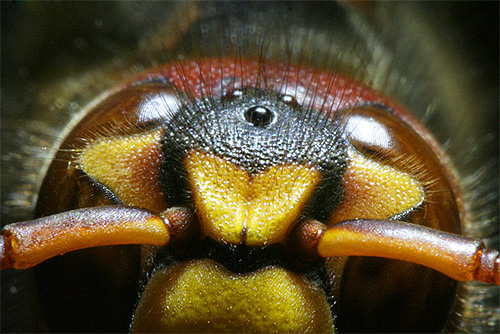
The main eyes have a rather complex structure, and consist of a great many individual elements that form a mosaic image. They focus less than, for example, in humans, but perfectly capture any movement of objects in sight.
As for the extra eyes, each of them is more like a human and even has its own pupil.
In another photo of the wasp under a microscope, you can clearly see the extra eyes on the insect's forehead:

Wasp sizes vary widely. So, for example, a giant scolium from Southeast Asia grows up to 6 cm in length; the Asian giant hornet is not far behind it - about 5-5.5 cm. But the overwhelming majority of representatives still have more standard sizes for insects. In this case, usually (but, nevertheless, not always) body sizes correspond to the degree of danger of the insect.
Wasp's sting, poison and its bites
Despite the fact that many wasps very successfully wield their jaws, attacking other insects or defending themselves against enemies, their sting is the main means of defense.
Over many millions of years of evolution, the egg-laying characteristic of Hymenoptera has become harder, stronger and connected with poisonous glands, becoming one of the most advanced killing tools in the insect world.
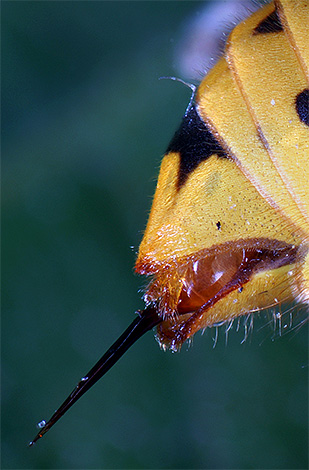
Unlike a bee, a wasp can sting a person several times in a row: its sting does not have chipping and therefore can be easily removed from fairly soft skin. Theoretically, the number of bites per attack is limited only by the supply of wasp venom. However, in fact, even one bite is enough to drive several times larger enemy.
The poison wasps is a dangerous mixture of a large number of various substances: one of them, for example, causes severe irritation of nerve endings, the other leads to cell destruction, the third is responsible for the development of an allergic reaction, etc.

At the same time, among different representatives of families, the ratio of the components of the poison is strictly individual, and therefore the consequences of their bites differ. Thus, it cannot be said that all wasps sting equally.
The photo below shows a road wasp:
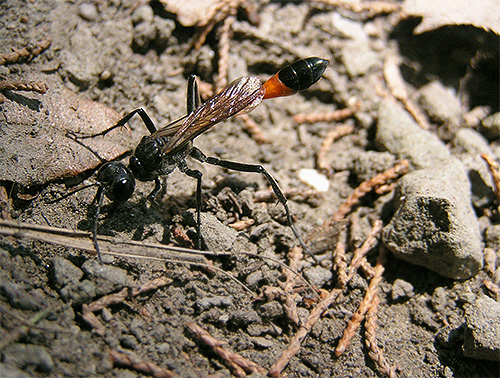
According to the descriptions of the victims, this insect stings more strongly than any other, and its bite is considered the second most painful among insect bites in general (the palm belongs here to South American ants-bullets).
And in this photo - a huge Japanese hornet, which has an extremely toxic and allergenic poison. Every year, a few dozen people are killed by insects of this species.Their bites often lead to hemorrhages and severe allergies.
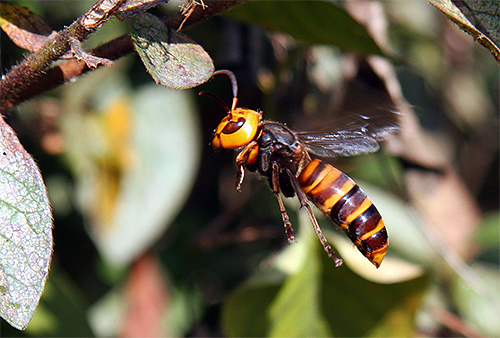
And this insect in the photo is scoli:

Despite its impressive size, scoliosis sting is rather weak, and the pain at the site of the bite is not felt for long. Such an unusual feature is explained by the fact that the purpose of a chipped bite is mainly the immobilization of the victim, not its death.
It has long been believed that the hornet bite is incredibly painful and much more sensitive than wasp sting. In fact, the poisons of the hornet and the wasps are in many ways similar, and the severe pain and serious consequences that everyone talks about, mentioning the hornet, are explained by the large amount of poison injected. In addition, the hornet venom is somewhat more allergenic and often leads to severe outcomes - anaphylactic shock, extensive edema, and even death.

On a note
Fear of bees and wasps is called apiphobia from the Latin "apis", which means "bee".
Brave predators
A unique feature of the OS is the nature of their nutrition, which is largely determined by the specificity of the life cycle. In their development, these insects undergo the so-called complete metamorphosis: the larva has a thick worm-like body and is not at all like an elegant fast adult insect either externally or in its “gastronomic predilections”.
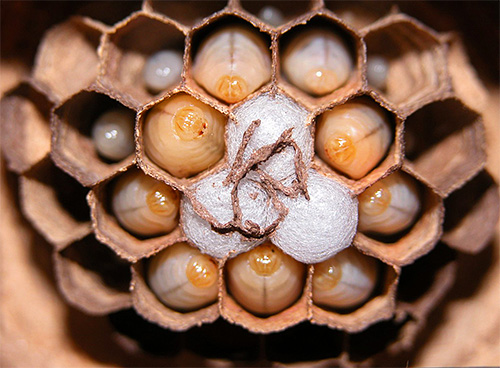
The larva of a wasp is a predator that feeds only on animal food, while the adult insects mostly manage with nectar of flowers, sweet juicy berries and fruits. In some cases, the attitude to food reaches even the extreme: for example, among philanthropists, also called bee wolves, the larva is physically unable to digest carbohydrates.
It is interesting
Even huge Scoli, having an eerie appearance and gloomy coloring in adulthood, feed on the nectar of flowers, but their offspring grows and develops, slowly eating the larvae of the May beetle paralyzed by their parents.
For their larvae, wasps produce the most diverse protein feed, always choosing the most tasty pieces in their eyes. In public wasps, adult individuals catch other insects or bite off pieces of meat from carrion or spoiled fish, then chew on this food, mix it with their digestive enzymes, and only then feed the offspring with the resulting mixture.
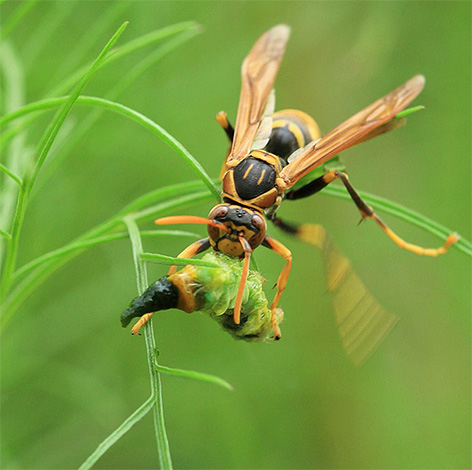
It is interesting
The larvae of social wasps do not secrete excrement, which would simply have nowhere to go from the honeycomb. All waste products accumulate in their body, and after the departure of the young wasps remain in the comb. Then working individuals clean the vacated "cradle".
If we talk about single wasps, then their feeding algorithm is completely different and not much like that of public relatives. Females of solitary wasps, as a rule, catch arthropods, paralyze them with their poison, hide them in a mink, and then lay eggs in their prey. The resulting living "canned" will long serve as a source of food for the larvae developing from eggs.
Interestingly, the victim, with eggs laid in it, usually lives up to pupation of his tormentor. The larva eats it, starting with those organs, the loss of which will not lead to a quick death, and therefore, although paralyzed prey may lose most of the body, it will still be alive.
The range of potential victims is very wide. However, some species of wasps are highly specialized and hunt, for example, only on spiders or bedbugs (at the same time they can attack very large tarantulas).
The photo below depicts such an attack on a spider:
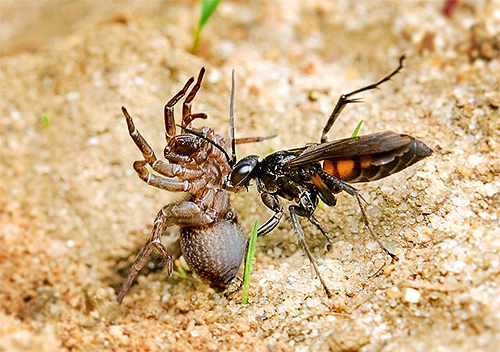
But the hornets, for example, eat literally everything that consists of meat. Scientists have discovered among their victims a variety of insects, slugs, worms, centipedes, even lizards and rodents.However, as entomologists suggest, hornets do not attack the same mice, but only feed themselves with the remains of a table of wild cats.
It is interesting
The tropical emerald cockroach wasp (see photo below) strikes the brain of its victims - the cockroaches - so precisely that they can then move, only controlled by the wasp. It turns out a kind of zombie cockroach. After the bite, the predator leads the victim for the antennae into its hole, where it lays an egg on it.
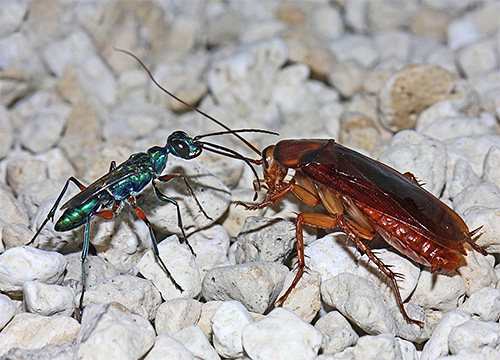
Special relationships with striped predators around the world have beekeepers. For example, hornets against bees are a very formidable force: some large species of them can ruin thousands of hives.
In general, wasps play an important role in nature, including from the point of view of human agricultural activity, because they are able to destroy a large number of harmful insects. In addition, wasps play the role of a kind of orderlies of insect populations and factors of natural selection.
Lifestyle and reproduction of wasps
Lifestyles for solitary and social wasps are quite different. For example, harvesting paralyzed prey is the only thing that an adult single wasp can “offer” to its larva.With this, care for the offspring is stopped by her (only in some species the female can occasionally visit the burrows and bring additional food into them).
In public wasps everything is much more complicated. Their founder queen hibernates in a safe shelter (in a hollow, under a stone or under the bark), and in the spring begins to build a nest and lay its first eggs in it.
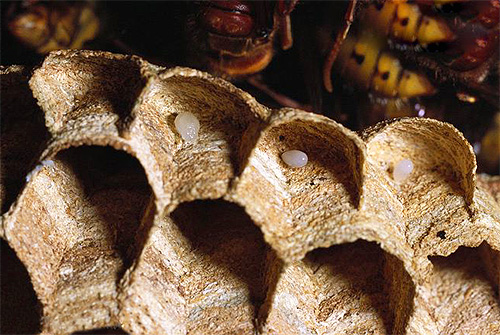
Young insects hatching from these eggs take all further cares about building a nest and getting food, and then the task of the uterus is reduced only to the expansion of the family.
The social wasps build the nest itself from pieces of young tree bark, thoroughly chewed and sealed with saliva. The output is a kind of paper, which serves as the only building material for these insects. If we are talking about large enough nests of hornets, then in this case the winged builders can completely strip the bark from the young branches of individual trees.
In the photo - wasp nest under construction:
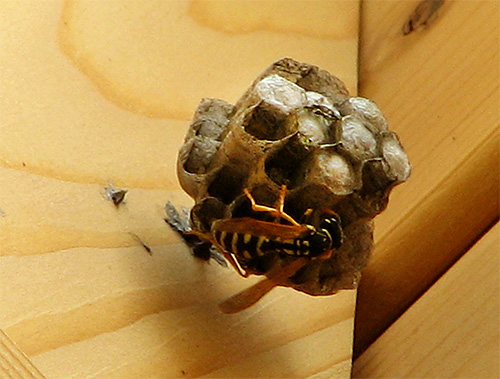
It is interesting
The wasps never sleep, although in the dark their activity is significantly reduced. At night, they are in the nest and usually chew on the bark collected during the day.Near the nest, the noise from such chewing is sometimes clearly heard even at a distance of several meters.
All insects in the nest are sterile females. It is only at the end of summer that the uterus begins to lay eggs, from which emerge capable females and males. These young individuals swarm, mate among themselves, and then forever leave the parental nest.
Fertilized females soon find shelter for themselves for the winter, as their queen made them, and the males die. At the end of the season, all working individuals, along with the old female founder, are dying.
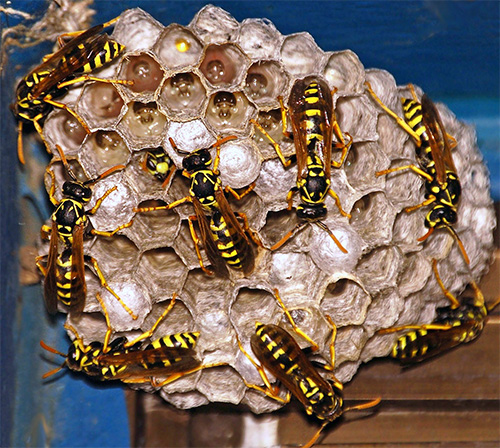
With the arrival of spring, the life cycle of wasps begins anew, and everything repeats according to the scenario set by nature ...
Enemies and parasites wasps
Despite the seemingly high security and ability of the os to collective defense of the nest, they have many enemies. The main ones are parasites.
In the wasp nests live numerous ticks, beetles, some riders and even certain types of parasitic wasps. They all feed on the larvae, successfully defending themselves from working insects with the help of their stinger, small size or skillful disguise.
Wasps are eaten by bears, wolverines, hedgehogs and many other wild animals who are not afraid of the bites of defending insects.Inexperienced domestic dogs and cats, too, sometimes are not averse to eat striped "flies", but very often they suffer because of this.
Some birds also eat wasps. For example, the bee-eaters perfectly mastered the art of hunting these insects: the bird grabs the victim across the body, hits the branch with it, and then crushes and swallows.
But the European bobcat, a large bird of prey, catches insects with its paws on the fly, but carefully feeds off its sting before feeding its chicks. It is interesting that the visual acuity of the blackbird is such that he can watch his victim in the summer forest from a distance of several hundred meters.
On the photo there is a blackbird, surrounded by angry insects:
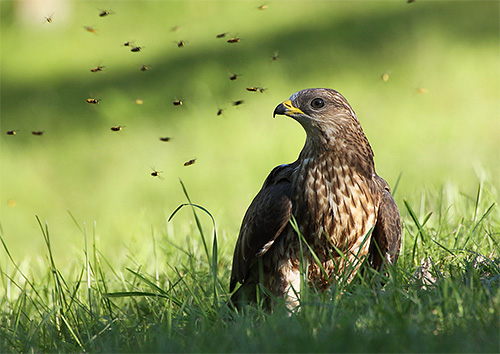
And yet, despite the fairly large number of natural enemies, the main threat to many wasps in nature is the reduction of habitats suitable for their life. Thus, today the common hornet is becoming a rarity, usually arranging nests in the hollows of trees, but often not finding a sufficient number of such shelters due to immense deforestation in some regions.
As for some other types of wasps,then they may never be found anywhere else in the quantities necessary to preserve the population, so, for example, tilling even a small slope can lead to their disappearance in a single area.
Given the rather sad world statistics, the governments of some countries are already conducting special environmental measures aimed at protecting certain types of wasps.
Interesting Video: Wasp Battle with Spider
Not everyone knows the similarities and differences between bees and wasps

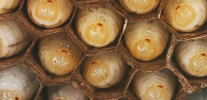
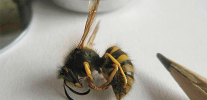

Just super. It helped me!
Have you lost the hornets? 🙂